| Knife Blades | Knife
Construction | Knife Handles | Types
of Knives
Maintaining and Storing Knives | Tools
for Sharpening Knives
There are hundreds of different types of knives. If you
are a beginner cook, start with 3 or 4 types of high quality knives.
A good foundation is to begin with a chef's knife, a paring knife, and
a bread knife. Specialty knives are useful, but can be expensive. Choose
a set you can add to in the future.
To choose a knife that is of good quality and best fits
your needs, you need a basic knowledge of the various parts and construction
of a knife.
Knife Blades
Carbon Steel - Carbon Steel has been used
in the making of blades for many years. Carbon steel blades are tough
and take a better edge with little effort. Carbon steel blades discolor
when they come in contact with foods that are high in acid, such as
tomatoes and citrus fruit. The blades must be treated with care to
avoid discoloration and rusting. Wash and dry thoroughly after use.
|
Tip: When storing knives with carbon steel blades,
lightly coat the blades with flavor free vegetable oil to help
prevent discoloration and rust.
|
Stainless Steel - Unlike carbon steel, stainless steel blades
do not discolor or rust, however, they are not hard enough to maintain
the best edge.
High Carbon Stainless Steel - A combination
of the best attributes of carbon steel and stainless steel blades.
They have the toughness and ability to hold an edge and do not discolor.
Titanium - Titanium blades are made from
a mold of titanium and carbides. When compared to steel, titanium
is lighter, more wear resistant, and holds its edge longer. The titanium
blade is more flexible than steel, they work best for tasks such as
boning and filleting.
Ceramic - Ceramic blades are made of zirconium
oxide and aluminum oxide. Although they are much more delicate than
steel knives, they tend to hold their edge up to 10 times longer.
Once the blades have dulled, they must be sharpened by a professional.
Plastic - Plastic blades are used with
the primary goal of preventing vegetables and such from becoming discolored
from the blade of a knife. Plastic blades are not very sharp and require
some force when cutting.
Hollow Ground - A knife blade with concave beveled edges created by starting midway, or lower, from the top of the blade and grinding or tapering each side of the blade thinner toward the bottom, or cutting edge, of the blade. This type of cutting edge results in a very thin and exceptionally sharp edge that can be easily sharpened. It is a type of blade that is excellent for slicing but not for chopping activities since the higher impact of the chopping action dulls or may chip the blade. Although these blades often have very sharp edges, the blade lacks the balance and longevity of a taper ground blade.
Taper Ground - A knife blade that is
manufactured with a single sheet of metal and has been ground so
that it tapers smoothly from the spine to the cutting edge. This
type of blade desired on knives that are used frequently.
Tang - The tang is the part
of the knife blade that extends into the handle. The length of the tang
is thought to be significant in the ability to balance and control a
knife. Various manufacturers believe that producing a knife with a tang
that extends throughout the full length of the knife is most desirable.
Other manufacturers argue that each piece of a knife benefits from using
a different metal. Investing in a solid, heavy, well balanced knife
that you feel comfortable with is the overall objective.
Metal Rivets - Metal rivets are used to
secure the tang to the handle of the knife. To prevent irritation
to the hand, the rivets should be completely smooth and lie flush
with the surface of the handle. In addition, this will help prevent
debris and microorganisms from collecting in the spaces between the
handle and the rivets.
Bolster - A bolster is a thick piece of
metal (collar or shank) that is placed between the handle and the
blade. The purpose of a bolster is to provide safety from the blade
and add balance to the knife.
Wood - Wood handles provide an excellent
grip, but requires more maintenance than a plastic or stainless steel
handle. Critics argue that wood handled knives absorb microorganisms.
|
Tip: Never submerge wood handled knives in water
and rub the wood occasionally with mineral oil.
|
Wood Handles Infused with Plastic - A combination
of the best attributes of wood handles and molded plastic handles. They
have an excellent grip but do not require the maintenance all wood handles
require. They are also not as porous as wood handled knives, preventing
the absorption of microorganisms.
Molded Plastic or Composition - Molded
plastic handles are much easier to care for than wooden handles. They
will not absorb debris and microorganisms and are easily cleaned.
Critics argue that handles made with molded plastics become brittle
over time and can become slippery in the hand.
Stainless Steel - Metal handled knives
last longer and add weight to the knife. Critics argue that they become
slippery in the hand.
Types of Knives
The following descriptions and images of knife types are general examples
only. Although the basics of each knife style is the same, manufacturers
have many variations of how each type of knife looks.
| Chef's Knife | Carving
Knife | Paring Knife | Serrated
Knife | Utility Knife | Boning
Knife |
| Filet Knife | Cleaver Knife
| Santoku Knife | Steak
Knife | Mincing Knife | Oyster
Knife |
| Devein Knife | Clam Knife
| Grapefruit Knife |Cheese
Knife |
| Chestnut Knife | Tourne
Knife | Peeling Knife | Slicer
|
|
Chef's Knife
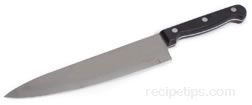
|
Chef's Knife - Also
called a cook's knife. An all purpose kitchen knife that is used
for most types of chopping, dicing, mincing, and slicing.
Chef's knives come various lengths of 6, 8, 10, and 12 inches.
The length of the knife you purchase is significant. The longer
the knife, the heavier and more difficult it will be to handle.
Small handed cooks should choose shorter blades while large handed
cooks will prefer longer blades.
|
| Carving Knife - A
knife with an 8 to 15 inch blade used for carving large roasts,
poultry, and filleting large fish. The blade edge of a carving knife
is either smooth or beveled. The blade should be large enough to
carve across the cut of meat, poultry, or fish in one sweep.
The blades vary in flexibility. A carving knife with a rigid
blade is used for slicing roasted meats; more flexible blades
for poultry; and the most flexible blades are for slicing smoked
pork and fish.
Carving knives are often sold in sets with a carving fork. A
carving fork is designed to hold the meat steady while slicing
and keep the hand safe while cutting. These forks typically have
two long, curved prongs.
Some manufacturers refer to carving knives over 9" as slicers.
|
Carving Knife

|
|
Paring Knife

|
Paring Knife
- A small knife with a sharp blade that is generally three
to four inches long. It is easy to handle and works well for peeling
and coring foods. The blade is typically thin and narrow and tapers
to a point at the tip. |
| Serrated Knife
- A knife with a sharp edge and saw-like notches or teeth. The blade
of a serrated knife is 5 to 10 inches long. Serrated knives are
difficult to sharpen; therefore many chefs spend less on a serrated
knife and buy new more often.
A serrated knife with a long blade is used to slice through food
that is hard on the outside and soft on the inside, such as slicing
through the hard crusts of bread.
A serrated knife with a short, thin blade is intended for slicing
fruits and vegetables.
|
Serrated Knife

|
|
Utility Knife

|
Utility
Knife - A small lightweight knife, which has a blade that
is generally 4 to 7 inches long and is used for miscellaneous light
cutting such as fruits and vegetables. |
|
Boning Knife -
A knife with a thin short blade, typically 5 or 6 inches long,
used to remove the main bone within a cut of meat, such as a ham
or a beef roast. A boning knife will typically have a long narrow
blade for ease of manipulation around bones, that is rigid and
proportioned to the size of the bones being removed. Bigger cuts
of meat require a larger more rigid blade that will not be too
flexible and cause injury if it bends too easily, while smaller
meat cuts can be trimmed and boned using a smaller less rigid
blade.
|
Boning Knife

|
|
Filet Knife

|
Filet Knife
- A knife consisting of a thin flexible blade, typically 6 to 11
inches long, used for filleting fish. The narrow blade enables the
knife to cleanly move along the backbones of the fish, in and around
areas adjacent to bones, and to evenly slice along the skin, removing
it easily from the flesh. |
| Cleaver - A knife
with a wide rigid blade approximately 6 inches in length, which
tapers to a sharp cutting edge. This tool is used to chop, shred,
pound, or crush food ingredients and materials. The blade of the
cleaver is thick, somewhat heavy and well balanced with a beveled
cutting edge, which allows for ease of chopping through vegetables
or materials as hard a bones with the beveled blade. The flat blunt
side of the blade can be used to pulverize meat. If the handle is
flat on the end it may be used to crush seeds, garlic or other similar
ingredients. A hole is typically provided on the top end of the
blade to allow for ease of hanging this tool. |
Cleaver
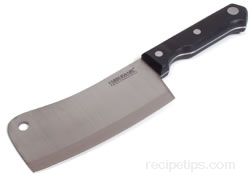
|
Santoku
Knife - A type of knife commonly used to prepare ingredients
for Asian food dishes. This knife is very similar to a chef's
knife with a wide blade that has a long straight edge curving
up slightly at the end. The main difference is that the santoku
knife has a wider blade that is thinner in thickness, shorter
in length, and curves up very gradually at the end providing a
straighter cutting edge. Constructed of stainless steel, this
knife will typically be expensive to purchase, since it is precision
made to be well balanced and well formed for ease of handling
and greater control. With a thinner blade than a chef's knife,
the santoku can cut smoothly and more precisely through dense
vegetables, which may have a tendency to provide more resistance
when using thicker width blades.
Versions of this knife are manufactured with either
a standard-edged blade or a hollow ground edge, also known as
a granton edge. The purpose of the granton style blade is to assist
with keeping particles from sticking to the knife edge as it chops
small bits of food as well as a friction reducer to provide less
drag when chopping, which enables easier and faster motion. Santoku
knives are used for chopping, dicing, and slicing foods into narrow
or fine pieces so they can be added as ingredients to enhance
the look or flavors of the various foods being prepared. This
knife also works well for butterflying boneless chicken breasts,
providing a manageability and ease of handling for the cutting
required to butterfly poultry.
|
Santoku Knife
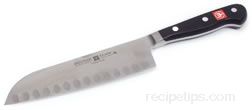
|
|
Steak Knife

|
Steak Knife
- A knife used for cutting main courses such as steak and
chicken. The knife usually has a blade that is 4 to 6 inches long
and varies in thickness. Depending on the manufacturer, the blade
may or may not be serrated. |
Mincing
Knife - A knife that can be used to mince or cut foods into
smaller bits for seasoning sauces, soups, salads, and other dishes.
Mincing knives can be either single or double bladed to cut a variety
of foods into very small pieces. A mincing knife is also referred
to as a Mezzaluna, Mezzaluna chopper or Mezzaluna knife. Another
version of a mincing tool is the rolling mincer or rotary mincer.
This utensil consists of numerous circular blades, close together
mounted on a handle, enabling the user to roll the tool back and
forth over the herb as the blades do the mincing.
|
Single Bladed Mincing Knife
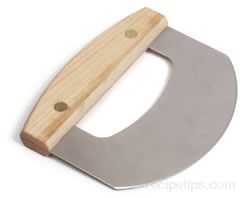
Double Bladed Mincing Knife
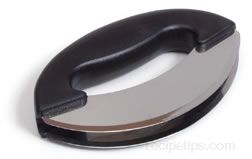
|
|
Oyster Knife
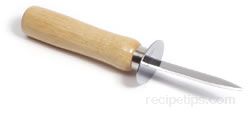
|
Oyster Knife
- A kitchen utensil that is used to pry open the hard shell
of an oyster or clam in order to remove the meat. Typically, the
knife will have a sharp, beveled blade that can be inserted into
the tightly closed shell to pry the shell apart. The blade is then
used to cut through the muscle and oyster membrane. A round shield
is built into the handle in order to keep the knife and hand from
going into or through the sharp edged shell. |
| Devein Knife -
A kitchen utensil that is used to remove the large vein that runs
down the length of a shrimp. A fork can be inserted in the back
of the shrimp to pull out the vein or a deveining knife can be used
to cut a slit down the length of the shrimp. This tool is inserted
at one end of the shrimp and then pushed up through the entire body
to remove the vein and the shell at the same time. |
Devein Knife

|
|
Clam Knife
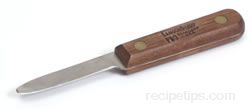
|
Clam Knife
- A kitchen utensil that is used to pry open the hard shell
of a clam or an oyster in order to remove the meat. Typically, the
knife will have a beveled edged blade that can be inserted into
the tightly closed shell, twisting the blade to pry the shell apart.
A round shield is built into the handle in order to keep the knife
and hand from going into or through the sharp edged shell. |
| Grapefruit Knife -
kitchen utensil that is made for ease of cutting the meat of the
fruit away from the grapefruit skin when preparing a half grapefruit
for serving. There are several varieties of this tool available,
either single or double bladed, each containing at least one serrated
blade. The dual bladed knives have serrated blades on each end of
a handle placed in the center. The curved blade on one end is used
for cutting the meat away from the outer skin. The second blade
may consist of two closely aligned parallel blades or one blade
with a slit in the center, each used to cut between the lining that
separates the inner meat into sections. The grapefruit knife effectively
serves a good purpose of separating the meat sections of grapefruits
better than the average kitchen knife. |
Grapefruit Knife

|
|
Cheese Knife

|
Cheese Knife -
A kitchen utensil that is thinly shaped to cut easily through soft
or hard textured cheese. This knife may have a forked tip that is
used as a lifter for pieces of cheese as they are cut. This knife
may also be referred to as a forked-tip utility knife, which is
used as a bar knife for cutting through citrus fruits or spearing
garnishes for drinks as may be required for pickles, onions or maraschino
cherries. |
| Chestnut Knife
- A kitchen utensil that is used to score the chestnut prior to
roasting. By carving a line, a cross or an "X" into the
shell of the unroasted nut, it allows it to breathe during roasting
and to resist exploding as the steam builds up. The chestnut knife
is short shafted in order to keep the cut confined to the shell
without going too deeply to pierce the inner skin. When preparing,
place the nuts in a shallow pan and roast at 425 degrees for 30
minutes or slightly less. Following roasting, the knife can then
be used to open the shell to remove the meat. To remove the nut,
make a single score/cut fully around the middle of the shell. The
nut may stick to the skin, but should be adequately separated to
remove the nut easily. |
Chestnut Knife
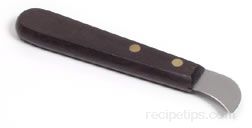
|
| Tourne Knife
or Peeling Knife - A knife used to peel, slice, trim and
dice small fruits, vegetables and cheese. The blade is curved and
usually 2-3 inches long. |
Slicer - A knife
used to slice cooked meat. The blade is long, typically 8-12 inches,
with a round or pointed tip. Depending on the manufacturer, the
blade may be flexible or rigid. Some manufacturers refer to slicers
under 9" as carvers. |
Maintaining and Storing
Knives
-
To extend the lifetime of your knives, wash them by
hand. Knives that are washed in the dishwasher are exposed to harsh
detergents and scalding temperatures. Damage is likely to occur to
the sharp edge of a knife if allowed to be thrashed around in a dishwasher.
-
Wipe knives clean immediately after use to prevent
the discoloration of the blade. This practice will also help to prevent
foods from hardening onto the blade, allowing for ease of cleaning.
|
Tip: Safely clean knives by laying the blade
on a flat surface, wipe one side with a wet cloth, turn, wipe
the other side. Always use hot, soapy water to clean a knife that
has been used to cut poultry, meat, and/or fish.
|
-
If available, store knives in a wooden or polyethylene
knife block. If one is not available, store knives in a sheath or,
at a minimum, store the knives away from other utensils to prevent
damage to the sharp edges.
-
Use a wood or polyethylene cutting board. Wood and
polyethylene cutting boards create less resistance to the knife edge
than ceramic, metal, or plastic cutting boards.
|
Tip: To prevent contamination, wash cutting
boards with hot soapy water immediately after use. Cutting boards
should be sanitized by spraying the surface with a solution of
bleach and water, letting it stand for a short time, then wiping
it with a clean cloth.
|
Tools for Sharpening Knives

Sharpening Stone
A finishing tool that is used sharpen steel blades of knives and cutting
utensils. Most often rectangular in shape, the sharpening stone may
be 1/2 to several inches in thickness. Several common varieties include
the whetstone or the carbonrundum stone.
A whetstone is made from silicone dioxide minerals that are mined and
separated into soft, medium or hard grade stones. To prepare the stone,
a light weight lubricating oil is added to the stone in order to stimulate
the natural oils within that assist to sharpen a blade as one edge is
lightly rotated in a circular motion on the stone. Different grades
of stones provide different results for heavier or lighter grade steel
blades.
A carborundum stone is an abrasive material made of silicon carbide
that shapens blades and, over time, deteriotes in surface structure
as continual sharpening wears down the carbide material. Rectangular
in shape, this stone ofen has a smooth and a coarse side, referred to
as a double-grit stone. The coarse side is used first and then the knife
is finished by using the smooth side. To sharpen the blade, one side
of the blade is drawn straight across the flat surface of the stone.
The knife is then turned over to the other side of the blade and the
process is repeated. The coarse side enables the blade to be ground
into shape fairly quickly while the smooth side adds a smoother finish
and a sharper edge, eliminate minute rough edges.
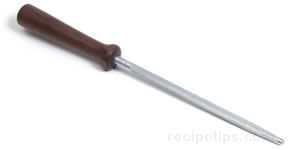
Sharpening Steel
A tool, generally made of steel, that is used to hone knife blades
and keep their edges straight in between sharpening. The tool can also
be glass, ceramic, or diamond-impregnated metal.
|




















